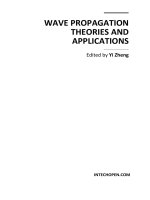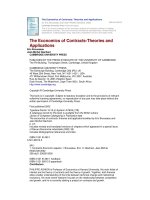- Trang chủ >>
- Khoa Học Tự Nhiên >>
- Vật lý
Scattering of electromagnetic waves theories and applications , tsang , ding , kong
Bạn đang xem bản rút gọn của tài liệu. Xem và tải ngay bản đầy đủ của tài liệu tại đây (37.23 MB, 436 trang )
SCATTERING OF
ELECTROMAGNETIC WAVES
Scattering of Electromagnetic Waves: Theories and Applications
Leung Tsang, Jin Au Kong, Kung-Hau Ding
Copyright
2000 John Wiley & Sons, Inc.
ISBNs: 0-471-38799-1 (Hardback); 0-471-22428-6 (Electronic)
WILEY SERIES IN REMOTE SENSING
Jin Au Kong, Editor
Asrar * THEORY AND APPLICATIONS OF OPTICAL REMOTE SENSING
Crane * ELECTROMAGNETIC WAVE PROPAGATION THROUGH RAIN
C~rlander and McDono~gh * SYNTHtTlC APERTURE RADAR: SYSTEMS
AND SIGNAL PROCESSING
Elachi * INTRODUCTION TO THE PHYSICS AND TECHNIQUES OF
REMOTE SENSING
Haykin, Lewis, Raney, and Rossiter
l
REMOTE SENSING OF SEA ICE
AND ICEBERGS
Haykin and Steinhardt
l
ADAPTIVE RADAR DETECTION AND
ESTIMATION
Hord * REMOTE SENSING: M~HODS AND APPLICATIONS
Janssen
l
ATMOSPHERIC REMOTE SENSING BY MICROWAVE
RADIOM~RY
Maffett 0 TOPICS FOR A STATISTICAL DESCRIPTION OF RADAR CROSS
SECTIONS
Steinberg and S~bbaram 0 MICROWAVE IMAGING TECHNIQUES
Szekielda * SATELLITE MONITORING OF THE EARTH
Tsang, Kong, and Shin * THEORY OF MICROWAVE REMOTE SENSING
Tsang, Kong, and Ding * SCAnERING OF ELECTROMAGNETIC WAVES:
THEORIES AND APPLICATIONS
Tsang, Kong, Ding, and Ao 0 SCA~ERING OF ELECTROMAGN~I~
WAVES: NUMERICAL SIMU~TIONS
Tsang and Kong
l
SCATTERING OF ELECTROMAGNETIC WAVES:
ADVANCED TOPICS
~~~~
SCATTERING OF
ELECTROMAGNETIC
WAVES
Theories and Applications
Leung Tsang
Jin Au Kong
Kung-Hau Ding
A Wiley-Interscience Publication
JOHN WILEY & SONS, INC.
New York
l
Chichester
l
Weinheim
l
Brisbane
l
Singapore
l
Toronto
Scattering of Electromagnetic Waves: Theories and Applications
Leung Tsang, Jin Au Kong, Kung-Hau Ding
Copyright
2000 John Wiley & Sons, Inc.
ISBNs: 0-471-38799-1 (Hardback); 0-471-22428-6 (Electronic)
This text is printed on acid-free paper. @
Copyright 0 2000 by John Wiley & Sons, Inc.
All rights reserved. Published simultaneously in Canada.
No part of this publication may be reproduced, stored in a retrieval system or transmitted in any
form or by any means, electronic, mechanical, photocopying, recording, scanning or otherwise,
except as pe~i~ed under Section 107 or t 08 of the 1976 United States Copyright Act, without
either the prior written permission of the Publisher. or authorization through payment of the
appropriate per-copy fee to the Copyright Clearance Center. 222 Rosewood Drive, Danvers, MA
0 1923, (978) 750-8400, fax (978) 750-4744. Requests to the Publisher for permission should be
addressed to the Permissions Department, John Wiley & Sons, Inc., 605 Third Avenue, New York,
NY 10158-00~2. (212) 8506011, fax (212) 850.6008, E-Mail: PERMREQ @ WlLEY.CQ~.
For ordering and customer service, call 1.80~-CALL-WILEY.
Library of Congress Cataloging in Publication Data is available:
Tsang, Leung.
Scattering of electromagnetic waves: Theories and Applications
ISBN O-47 t -38799-7 (cloth: alk. paper)
Printed in the United States of America,
10987654321
CONTENTS
PREFACE xi
CHAPTER 1
INTRODUCTION TO ELECTROMAGNETIC SCATTERING
BY A SINGLE PARTICLE *. . . . . . . . . . . . . .
l
. . . . . . . . . . . . . . . . . . 1
1
11 .
12 .
2
21 .
22
l
23 .
24
l
3
31 .
32 .
4
41
l
42 .
43
.
5
6
61 .
62
l
63
l
Basic Scattering Parameters
2
Scattering Amplitudes and Cross Sections
2
Scattering Amplitude Matrix 6
Rayleigh Scattering
9
Rayleigh Scattering by a Small Particle
9
Rayleigh Scattering by a Sphere
10
Rayleigh Scattering by an Ellipsoid
12
Scattering Dyads
14
Integral Representations of Scattering and
Born Approximation
Integral Expression for Scattering Amplitude
Born Approximation
Plane Waves, Cylindrical Waves, and
Spherical Waves
Cartesian Coordinates: Plane Waves
Cylindrical Waves
Spherical Waves
Acoustic Scattering
Scattering by Spheres, Cylinders, and Disks
Mie Scattering
Scattering by a Finite Length Cylinder Using the Infinite
Cylinder Approximation
16
16
18
21
21
22
24
30
32
32
41
Scattering by a Disk Based on the Infinite Disk Approximation 46
References and Additional Readings
52
-v-
Scattering of Electromagnetic Waves: Theories and Applications
Leung Tsang, Jin Au Kong, Kung-Hau Ding
Copyright
2000 John Wiley & Sons, Inc.
ISBNs: 0-471-38799-1 (Hardback); 0-471-22428-6 (Electronic)
vi
CONTENTS
CHAPTER 2
BASIC THEORY OF ELECTROMAGNETIC SCATTERING 53
1
11 .
12 .
13 .
14 .
2
3
4
5
51 .
52 .
53 .
6
7
71 .
72 .
8
81 .
82 .
83 .
Dyadic Green’s Function
Green’s Functions
Plane Wave Represent at ion
Cylindrical Waves
Spherical Waves
Huygens’ Principle and Extinction Theorem
Active Remote Sensing and Bistatic Scattering
Coefficients
Optical Theorem
Reciprocity and Symmetry
Reciprocity
Reciprocal Relations for Bistatic Scattering Coefficients and
Scattering Amplitudes
Symmetry Relations for Dyadic Green’s Function
Eulerian Angles of Rotation
T-Matrix
T-Matrix and Relation to Scattering Amplitudes
Unitarity and Symmetry
Extended Boundary Condition
Extended Boundary Condition Technique
Spheres
8.2.1 Scattering and Absorption for Arbitrary Excitation
8.2.2 Mie Scattering of Coated sphere
Spheroids
References and Additional Readings
54
54
55
57
59
60
66
68
73
73
75
79
81
83
83
88
91
91
97
100
102
104
106
CONTENTS vii
CHAPTER 3
FUNDAMENTALS OF RANDOM SCATTERING . . . . . .
. . . .
107
1
2
21 .
22 .
23 .
24 .
25 .
3
31 .
32 .
4
5
51 .
52 .
53 .
54 .
6
Radar Equation for Conglomeration of Scatterers
Stokes Parameters and Phase Matrices
Elliptical Polarization, Stokes Parameters, Partial
Polarization
Stokes Matrix
Scattering per Unit Volume and Phase Matrix
Rayleigh Phase Matrix
Phase Matrix of Random Media
Fluctuating Fields
Coherent and Incoherent Fields
108
116
116
123
124
127
129
131
131
Probability Distribution of Scattered Fields and Polarimetric
Description
132
Specific Intensity
140
Passive Remote Sensing
145
Planck’s Radiation Law and Brightness Temperature
145
Kirchhoff’s Law
149
Fluctuation Dissipation Theorem
152
Emissivity of Four Stokes Parameters 155
Correlation Function of Fields
161
References and Additional Readings
165
CHAPTER 4
CHARACTERISTICS OF DISCRETE SCATTERERS AND
ROUGH SURFACES . . . . . . . . . . . . . . . . . . . . . . . . . . . . . . . . . . . . ‘. . . . 167
1 Ice
168
2
Snow
170
3
Vegetation
171
4
Atmosphere
172
CONTENTS
. . .
Vlll
5
51 .
52 .
6
7
8
Correlation Function and Pair Distribution
Function
Correlation Function
Pair Distribution Function
Gaussian Rough Surface and Spectral Density
Soil and Rocky Surfaces
Ocean Surface
References and Additional Readings
CHAPTER
5
SCATTERING AND EMISSION BY LAYERED MEDIA
. . .
1
2
21 .
22 .
23 .
3
4
Incoherent Approach of Radiative Transfer
Wave Approach
Reflection and Transmission
Dyadic Green’s Function for Stratified Medium
Brightness Temperatures for a Stratified Medium with
Temperature Distribution
Comparison Between Incoherent Approach and
Coherent Approach
Applications to Passive Remote Sensing of Soil
References and Additional Readings
CHAPTER
6
SINGLE SCATTERING AND APPLICATIONS . . . . . . . .
1 Single Scattering and Particle Position Correlation
2
Applications of Single Scattering
21 . Synthetic Aperture Radar
22
.
Interferometric SAR
23 . Active Remote Sensing of Half-Space Random Media
References and Additional Readings
I.73
174
176
179
184
185
195
199
200
203
203
207
212
217
220
229
231
232
237
237
248
252
258
CONTENTS
ix
CHAPTER 7
RADIATIVE TRANSFER THEORY . . . . . . . . . . . . . . . . . . . . . . . . 259
1 Scalar Radiative Transfer Theory 260
2 Vector Radiative Transfer Theory
269
21 . Phase Matrix of Independent Scattering 269
22 . Extinction Matrix 272
23 . Emission Vector 275
24 . Boundary Conditions 283
References and Additional Readings 286
CHAPTER 8
SOLUTION TECHNIQUES OF RADIATIVE
TRANSFER THEORY . . . . . . . . . . . . . . . . . . . . . . . . . . . . . . . . . . . . . . 287
1
11 .
12 .
13 .
14 .
15 .
2
21 .
22 .
23 .
24 .
25 .
26 .
Iterative Method 288
Iterative Procedure 288
Integral Equation for Scattering Problems
293
Active Remote Sensing of a Half-Space of Spherical Particles
298
Active Remote Sensing of a Layer of Nonspherical Particles 303
1.4.1
Numerical IIIustrations with Finite Dielectric Cylinders 310
Second-Order Scattering from Isotropic Point Scatterers 322
Discrete Ordinate-Eigenanalysis Method
324
Radiative Transfer Solution for Laminar Structures
324
Numerical Procedure of Discrete Ordinate Method: Normal
Incidence 328
Active Remote Sensing: Oblique Incidence
337
Discrete Ordinate Method for Passive Remote Sensing
343
Passive Remote Sensing of a Three-Dimensional Random
Medium
349
Passive Remote Sensing of a Layer of Mie Scatterers
Overlying a Dielectric Half-Space
352
CONTENTS
X
3
31
.
32
.
33
.
34
.
4
Invariant Imbedding
One-Dimensional Problem
Passive Remote Sensing of a Three-Dimensional Scattering
Medium with Inhomogeneous Profiles
Passive Remote Sensing of a Three-Dimensional Random
Medium
Thermal Emission of Layers of Spherical Scatterers in the
Presence of Inhomogeneous Absorption and Temperature
Profiles
Diffusion Approximation
References and Additional Readings
CHAPTER 9
ONE-DIMENSIONAL RANDOM ROUGH SURFACE
SCATTERING . . . . . . . . . . . . . . . . . . . . . . . . . . . . . . . . . . . . . . . . . a
1 Introduction
2 Statistics of Random Rough Surface
21 . Statistics, Correlation Function and Spectral Density
22
.
Characteristic Functions
3 Small Perturbation Method
31
.
Dirichlet Problem for One-Dimensional Surface
32
.
Neumann Problem for One-Dimensional Surface
4 Kirchhoff Approach
41
.
Dirichlet Problem for One-Dimensional Surface
42
.
Neumann Problem for One-Dimensional Surface
References and Additional Readings
INDEX
419
362
363
370
373
374
380
386
389
390
392
392
396
397
397
403
407
408
415
417
PREFACE
Electromagnetic wave scattering is an active, interdisciplinary area of
research with myriad practical applications in fields ranging from atomic
physics to medical imaging to geoscience and remote sensing. In particular,
the subject of wave scattering by random discrete scatterers and rough sur-
faces presents great theoretical challenges due to the large degrees of freedom
in these systems and the need to include multiple scattering effects accu-
rately. In the past three decades, considerable theoretical progress has been
made in elucidating and understanding the scattering processes involved in
such problems. Diagrammatic techniques and effective medium theories re-
main essential for analytical studies; however, rapid advances in computer
technology have opened new doors for researchers with the full power of
Monte Carlo simulations in the numerical analysis of random media scatter-
ing. Numerical simulations allow us to solve the Maxwell equations exactly
without the limitations of analytical approximations, whose regimes of va-
lidity are often difficult to assess. Thus it is our aim to present in these three
volumes a balanced picture of both theoretical and numerical methods that
are commonly used for tackling electromagnetic wave scattering problems.
While our book places an emphasis on remote sensing
applications, the ma-
terials covered here should be useful for students and researchers from a
variety of backgrounds as in, for example, composite materials, photonic de-
vices, optical thin films, lasers, optical tomography, and X-ray lithography.
Introductory chapters and sections are also added so that the materials can
be readily understood by graduate students. We hope
he1 .p stimulate new ideas and innovative approaches to
that our book would
electromagnetic wave
scattering in the years to come.
The increasingly important role of numerical simulations in solving elec-
tromagnetic wave scattering problems has motivated us to host a companion
web site that contains computer codes on topics relevant to the book. These
computer codes are written in the MATLAB’ programming language and
are available for download from our web site at www . emwave. corn. They are
provided to serve two main purposes.
The first is to supply our feaders a
hands-on laboratory for performing numerical experiments, through which
the concepts in the book can be more dynamically relayed. The second is
to give new researchers a set of basic tools with which they could quickly
build on projects of their own. The fluid nature of the web site would also
allow us to regularly update the contents and keep pace with new research
developments.
- xi -
xii
PREFACE
The present volume covers the basic principles and applications of elec-
tromagnetic wave scattering and lays the groundwork for the study of more
advanced topics in Volumes II and III. We start in Chapter 1 with exact
and approximate solutions of wave scattering by a single particle of simple
shape. Such problems can be solved exactly by expanding the fields in terms
of scalar or vector waves in separable coordinates, depending on the geometry
of the scatterer. When the size of the scatterer is small, Rayleigh scatter-
ing represents a simple and valid approximation. When scattering is weak,
the Born approximation can be applied to the volume integral equation for
the internal field. Approximate solutions are also useful when the scatterer
lacks perfect symmetry as in the case of a finite cylinder. In Chapter 2, we
discuss basic scattering theory. We introduce the Green’s function for the
wave equation and its various coordinate representations. From the vector
Green’s theorem, we derive the Hugyens’ Principle and the extinction the-
orem, which are especially useful for formulating surface integral equations
in scattering problems. The reciprocity principle leads to useful symmetry
relations in the scattering amplitudes and the Green’s function, while energy
conservation
the extended
leads to the optical theorem. The T-matrix formulation with
boun .dary condition technique is a popular method that can
be used to calculate scattering from an arbitrarily shaped object. We give
explicit results for dielectric spheres and spheroids.
In Chapter 3, we begin the study of electromagnetic scattering by a ran-
dom collection of scatterers. The concepts of fluctuating fields and ensemble
averaging are of central importance in random media scattering. These and
related ideas are explored in this chapter. The specific intensity is often used
to describe energy transport through a random medium. The fully polari-
metric description of the specific intensity is provided by the Stokes vector.
As an application to passive remote sensing, we derive the emissivity of
the four Stokes parameters using the fluctuation dissipation theorem. Basic
radiative transfer (RT) theory elements including the extinction coefficient
and scattering phase matrix are also introduced. In contrast to conventional
RT theory, the phase functions are defined in terms of bistatic scattering
cross sections. This allows for the development of the dense medium radia-
tive transfer theory (DMRT) to be discussed in Volumes II and III. Many
natural media, e.g., snow, vegetation, and ocean surfaces, can be
effectively
modeled in terms of simple random media. Chapter 4 is devoted
to the sta-
tistical characterizations of such random discrete media and rough surfaces.
Useful characterizations include the pair distribution function for volume
scatterers and the power spectrum for rough surfaces.
PREFACE
. . .
Xl11
In Chapter 5, we consider scattering and emission by plane-parallel lay-
ered media, which provide simple but very useful models for geophysical
remote sensing. We solve this problem in two different ways: the coherent
or wave approach, which is exact, versus the incoherent or radiative transfer
approach. This gives us some insights into the approximations involved in
RT theory. In Chapter 6, we discuss the single scattering approximation,
where each particle is assumed to scatter independently. However, we take
into account
demonstrate
of the phase coherence in the addition of scattered fields. We
the existence
of an interes ting correlation effect in random me-
dia scattering known as the memory eflect. As will be shown in Volumes II
and III, this effect persists even when multiple scattering is included. Appli-
cations of single scattering to synthetic aperture radar (SAR) and random
media scattering are also discussed.
In Chapters 7 and 8, we take a closer look at the radiative transfer
equation and its solutions. The iterative method is useful when scattering is
weak and provides physical correspondence with different orders of multiple
scattering. When scattering is strong, the discrete ordinate eigenanalysis
approach can be used to obtain numerically exact solutions. For scattering
media with inhomogeneous profiles, the method of invariant imbedding can
be applied. Diffusion approximation is useful when, upon multiple scatter-
ing, the intensities have been diffused almost uniformly in all directions.
illustrate these solution techniques with extensive examples from active
passive microwave remote sensing.
In Chapter 9, we discuss wave scattering by random rough su .rfaces. De-
We
and
spite much theoretical and numerical efforts, the two “classical” analytical
approximations of small perturbation method and Kirchhoff approach
are
still the simplest and most widely used analytical met hods for solving ro1
45h
surface
Pro
blems. Here they are illustrated using one-dimensional rough sur-
faces w
ith Dirichlet and Neumann boundary conditions. Two-dimensional
rough surface scattering problems are discussed extensively in Volumes II
and III.
Acknowledgments
We would like to acknowledge the collaboration with our colleagues and grad-
uate students. In particular, we wish to thank Professor Chi Chan of City
University of Hong Kong, Professor Joel T. Johnson of Ohio State University,
Dr. Robert T. Shin of MIT Lincoln Laboratory, and Dr. Dale Winebrenner
of University of Washington.
The graduate students who completed their
Ph.D. theses from the University of Washington on random media scatter-
ing include Boheng Wen (1989), Kung-Hau Ding (1989), Shu-Hsiang Lou
xiv
PRl!3FACE
(1991), Charles E. Mandt (1992), Richard D. West (1994), Zhengxiao Chen
(1994), Lisa M. Zurk (1995), Kyung Pak (1996), Guifu Zhang (1998), and
Qin Li (2000). Much of their dissertation works are included in this book.
Financial supports from the Air Force Office of Scientific (Research, Army
Research Office, National Aeronautics and Space Administration, National
Science Foundation, Office of Naval Research, and Schlumberger-Doll Re-
search Center for research materials included in this book are gratefully
acknowledged. Special thanks are due to Chite Chen’ for her contributions
on the MATLAB programs, Henning Braunisch for careful proofreading on
parts of the manuscript, and Bae-Ian Wu for production assistance. We
would also like to thank Chi #On Ao for his help in editing and typsetting
the manuscript.
Leung Tsang
Seat tie, Washington
Jin Au Kong
Cambridge, Massachusetts
Kung-Hau Ding
Hanscom AFB, Massachusetts
May 2000
Chapter I
INTRODUCTION TO ELECTROMAGNETIC
SCATTERING BY A SINGLE PARTICLE
1
11 .
12
.
2
21
l
22 .
23 .
24 .
3
31
.
32 .
4
41
.
42 .
43 .
5
6
61 .
62 .
63 .
Basic Scattering Parameters
Scattering Amplitudes and Cross Sections
Scattering Amplitude Matrix
Rayleigh Scattering
Rayleigh Scattering by a Small Particle
Rayleigh Scattering by a Sphere
Rayleigh Scattering by an Ellipsoid
Scattering Dyads
2
2
6
9
9
10
12
14
Integral Representations of Scattering and
Born Approximation
Integral Expression for Scattering Amplitude
Born Approximation
16
16
18
Plane Waves, Cylindrical Waves, and
Spherical Waves
Cartesian Coordinates: Plane Waves
Cylindrical Waves
Spherical Waves
Acoustic Scattering
21
21
22
24
30
32
32
Scattering by Spheres, Cylinders, and Disks
Mie Scattering
Scattering by a Finite Length Cylinder Using the Infinite
Cylinder Approximation
Scattering by a Disk Based on the Infinite Disk Approximation
46
References and Additional Readings
52
41
-l
Scattering of Electromagnetic Waves: Theories and Applications
Leung Tsang, Jin Au Kong, Kung-Hau Ding
Copyright
2000 John Wiley & Sons, Inc.
ISBNs: 0-471-38799-1 (Hardback); 0-471-22428-6 (Electronic)
2 1 ELECTROMAGNETIC SCATTEZUNG BY SINGLE PARTICLE
A major topic in this book is the study of propagation and scattering
of waves by randomly distributed particles. We first consider scattering by a
single particle. This chapter and the next discuss and derive the scattering
characteristics of a single particle. Both exact and solutions are studied.
Scattering by a single particle is an important subject in electromagnetics
and optics. There exist several excellent textbooks on this subject [van de
Hulst, 1957; Kerker, 1969; Bohren and Huffman, 19831. We will treat those
topics that are pertinent to later chapters of multiple scattering by random
discrete scatterers.
1
Basic Scattering Parameters
1.1 Scattering Amplitudes and Cross Sections
Consider an electromagnetic plane wave impinging upon a particle which
has permittivity eP(?;) that is different from the background permittivity c
(Fig. 1.1.1). The finite support of Q(?;) - E is denoted as V.
The incident wave is in direction & and has electric field in direction &
that is perpendicular to &. The electric field of the incident wave is
(1.1.1)
where
;F=
32 + yij + x2
(1.1.2)
is the position vector, and
27T
k=W&iZ=X
(1.1.3)
is the wavenumber. In (1.1.3))
w is the angular frequency, p is the permeabil-
ity, and X is the wavelength. In (l.l.l), E. is the amplitude of the electric
field. The time harmonic dependence exp(-iwt) has been suppressed.
In the far field, the scattered field is that of a spherical wave with de-
pendence eik’
/T, where r is the distance from the particle. In general, the
particle scatters waves in all directions. Let E, be the far field scattered field
in direction of kS. Since Maxwell’s equations are linear, we write
E
s
= 2?,f(&, ki)Eoe”‘” (1.1.4)
r
where & is perpendicular to iS. The proportionality f &, &) is called the
scattering amplitude from direction & into direction &.
5 1.1 Scattering Amplitudes and Cross Sections
3
Figure 1.1.1 Scattering of a plane electromagnetic wave Ei(F) by a particle occupying
volume
V
and having permittivity ~p(‘j;). The scattered field is Es (?;).
The magnetic field associated with the incident wave is
whereq=d /-’ h p E is t e wave impedance. The Poynting vector denoting power
flow per unit area is
-
S
i= + (“i x JQ = @&j$
Similarly, for the scattered wave, the magnetic field is
(1.1.6)
and Poynting’s vector is
-
S
S-
fRe (Es x “:) = -!$Jks
Using (1.1.4) in (1.1.8) gives
(1.1.8)
3 - If&, &)I2 lEo12k
S-
T2
27
S
(1.1.9)
Consider a differential solid angle dS1, in the scattered direction k,
(Fig. 1.1.2). In the spherical coordinate system
do
S
= sin 0, d8, d&
(1.1.10)
At a distance r, the surface area subtended by the differential solid angle
dSt, is
dA = r2 dS2, = r2 sin OS dt?, dqbs
(1.1.11)
1 ELECTROMAGNETIC SCATTERING BY SINGLE PARTICLE
Figure 1.1.2 Differential solid angle
dfl,
= sin 8,
d0, d&
in spherical coordinates T, O,,
and &.
Then the differential scattered power dP, through dA is
dP
S
= I$1 dA = lSsl r2dS1, (1.1.12)
Putting (1.1.9) in (1.1.12) gives
dPs = If(i&, &),2y dR,
(1.1.13)
Using the Poynting vector of the incident wave, from (1.1.6), we have
dP
H = If&, h)12 da
(1.1.14)
i
The dimension of equation (1.1.14) is area. It is convenient to define a dif-
ferential scattering cross section a&&, &) by
dP
S
-
I I
S
= ad&, ii) dfl, (1.1.15)
i
Comparing (1.1.14) and (1.1.15) gives
ad(L, b) = If (b, &)I2
(1.1.16)
Integrating (1.1.14) over scattered angle gives
P
S
- =
II J
-
S
d&If (s, &)I2
i
(1.1.17)
$1.1 Scattering Amplitudes and Cross Sections
5
Thus the scattered power
-
P
s= s i
o PI
where us is the scattering cross section which is
(1.1.18)
(1.1.19)
Scattering Cross Section and Geometric Cross Section
The geometric cross section CT~ of a particle is its area projected onto a plane
that is perpendicular to the direction of incident wave &. Thus the power
“intercepted” by the particle, pT, from a geometric optics standpoint, is the
product of the geometric cross section and the magnitude of the incident
Poynting vector:
P
T
= ;Ti og
I I
(1.1.20)
We can compare o9 to us and pT to P’. Let D be the size of the object
(the maximum distance between two points inside the object). When the size
of the object D is much less than the wavelength, the results of Rayleigh
scattering theory indicate that
63
-
0
%
where 0 denotes the order of magnitude. Thus
P
S
-
P
0
r
(1.1.21)
(1.1.22)
in Rayleigh scattering. This shows that when the particle is small compared
with the wavelength, the power scattered by the particle is much less than
the product of geometric cross section and incident Poynting vector. In the
short wavelength limit, D >> A. Then
OS
-E
R
w
(1.1.23)
which is known as the geometric optics limit. It is important to remember
that the scattering cross section us also depends on the contrast between Q
and e. In the case of weak scatterers when Q, N e, we have
I I
Ep 1
2
CT,-
&
where “a’ denotes proportional to. Equation (1.1.24) is the result of the
Born approximation.
6
I ELEC’I’ROMAGNETIC SCATTERING BY SINGLE PARTICLE
Absorption Cross Section
The particle can also absorb energy from the incoming electromagnetic wave.
Let
fz (4
P-
= c;(T) + i(p)
(1.1.25)
From Ohm’s law, the power absorbed
(1.1.26)
where Eint(r) denotes internal field which is the electric field inside the
particle, di;; = dx dy dz, and the integration in (1.1.26) is over the three-
dimensional volume of the particle. The absorption cross section oa is defined
bY
P
a
CTa= -
I I
S
(1.1.27)
i
The total cross section of the particle is
ot
= oa + 0s
(1.1.28)
and the albedo of the particle is
(1.1.29)
Thus 0 < G < 1. The albedo is a measure of the fraction of scattering cross
- -
section in the total cross section.
1.2 Scattering Amplitude Matrix
We next generalize the concept of scattering amplitudes to include polariza-
tion effects. For the incident wave, the electric field Ei is pe.rpendicular to
the direction of propagation &. There are two linearly independent vectors
that are perpendicular to &. Let us call them & and &. Then
- (
E
i=
&Eai + &Ebi eiki-5:
> -
(1.1.30)
where Ei =
kki. The directions of &, iti, and & are such that they are
orthonormal unit vectors following the right-hand rule.
Similarly for the scattered wave, let k,, G,, and 6, form an orthonormal
system. Then
e
ikr
E
s
= itsEas + b,gEbs -
>
(1.1.31)
r
$1.2 Scattering Amplitude Matrix 7
Figure 1.1.3 Geometry for defining the orthonormal unit system based on scattering plane.
The scattering plane contains ki and &,. The angle between L, and k, is 0.
The scattered field components, EaS and I&, are linearly related to I&
and I&. The relation can be conveniently represented by a 2
x
2 scattering
amplitude matrix
.faa(k k) fab(ksT &)
Eai
.fba(L ii)
.fbb(h, &)
I[ I
Ebi
(1.1.32)
Orthonormal Unit Systems for Polarization Description
There are two common choices of the orthonormal unit systems (;ii, &, R,>
and (&, &,, is) that describe scattering by a particle.
A. System Based on Scattering Plane
Let the angle between & and ks be 0 (Fig. 1.1.3).
h h
incident direction ki and the scattered direction Ic,
plane. Let
h h
h
1 1
h
ai= i= S=as
be the unit vectors that are perpendicular to this
h h
1
ks x ii
i= s=
1
I I
ii, x ki
Then by orthonormality,
h h
b
i= i
2 = ki x ii
The plane containing the
is known as the scattering
plane and let
(1.1.33)
(1.1.34)
(1.1.35)
I ELECTROMAGNETIC SCATTEH-NG BY SINGLE PARTK’LE
h
h
b
s= s
2
=ks x is
(1.1.36)
In this l-2 system, the scattering amplitude matrix obeys the relation
(1.1.37)
The advantage of this system is that the scattering amplitudes can take
simple forms for particles with symmetry. The disadvantage for this system
is that the directions of ii and 2i depend on the scattered direction. For
example, let Z7i = 5?eikz. The incident wave is propagating in the direction
h h A A
k
. -
-
2 and with 2 polarization. If
ks
= $, then li = 5 and 2i = Gj and
the incident wave is ii polarized. However, if is = 2, then ii = e and
h
2
i
= 5!? and the incident wave is 2i polarized. The inconvenience is that Ei
is 2 polarized and propagation in 2 direction, and yet it is & or 2i polarized
h
depending on whether the scattered direction ks is 5 or 5%
Some useful relations for this orthonormal system are
h
is k
.
i
= co&
(1.1.38)
h
iis
2
.
i
= ks l ki = cos 0
(1.1.39)
h
f,
2
.
i
= j& . j& x ii = j& x ii . ii = j& x j$ = sin 0
I I
(1.1.40)
B. Vertical and Horizontal Polarization
In many problems there is a preferred direction, for example the vertical
direction that is labeled 2. In geophysical probing and earth remote sensing
problems, that will be the vertical axis which is perpendicular to the sur-
face of the earth. Then we can have vertical polarization Ci and horizontal
polarization iLi that form an orthonormal system with ii. We choose
h h
b
i- i-
h
2 x ki
(1.1.41)
that is perpendicular to both 2 and iCi.
Then
h
ai
= &
= iii x ki
(1.1.42)
Other names for vertical polarization are TM polarization, parallel polar-
ization, and p polarization. Other names for horizontal polarization are TE
polarization, perpendicular polarization, and s polarization. If Li is charac-
52 Rayleigkz Scattering
X
Figure 1.1.4 & and &, in spherical coordinates.
terized by the angles & and q& in spherical coordinates (Fig. 1.1.4), then
h
k
i
= sin Oi cos q5ik + sin & sin q$$ + cos 8iZ
(1.1.43)
Similarly, if kS is described by the angles 0, and &, then (Fig. 1.1.4)
h
k
s
= sin 8, cos q!Qk + sin 8, sin &$ + cos OS?
h
VS
= cos 0, cos q&ii? + cos 0, sin &$ - sin 8,2
h
h
S=
- sin $& + cos &$
(1.1.44)
2 Rayleigh Scattering
2.1
Rayleigh Scattering by a Small Particle
In Rayleigh scattering, the particle size D is much less than wavelength A.
In such a case an oscillatory dipole with moment p is induced inside the
particle. The field radiated by the dipole is the scattered field.
The far field radiated by a dipole 1, in the direction kS is
E
S=
(1.2.1)
10
1 ELECTROMAGNETIC SCATTERING BY SINGLE PARTICLE
Let the
electric field inside the particle be denoted
by ant,
where the sub-
script
int
title is
denotes internal. The polarization per unit volume inside the par-
P
int = Ep -
(
$%t
(1.2.2)
In Rayleigh scattering, the internal field is a constant vector inside the par-
ticle. The dipole moment of the particle is
-
P
= V,Fint
(1.2.3)
where vO is the volume of the particle. Using (1.2.2) and (1.2.3) in (1.2.1)
gives
E
s=
(1.2.4)
Using (1.2.4), the scattering amplitude matrix can be determined by relating
the internal field Eint to the incident field E;.
In Rayleigh scattering, the power absorbed by the particle is, from
(1.1.26),
2.2 Rayleigh Scattering by a Sphere
Consider a sphere of radius a < X centered at the origin. Then the internal
field inside the particle is
E
3E -
int = -
E
*
cp + 2E 2
(1.2.6)
The internal field Eint is parallel to the incident field Ei. Then using (1.2.6)
in (1.2.4) and vO = 47ra3/3,
where
-
-
eikr
f
0
r
+
h h
b (b
s 23.
f. =
k2a3s
P
(1
.
(1.2.8)
From (1.2.7)
E
as = fo(Gs
l
Ei)
(1.2.9a)
Ebs = fo(&
l
Ei)
(1.2.9b)
52.2 Rayleigh Scattering by a Sphere
11
We can calculate the scattering amplitude matrix using the scattering
plane orthonormal system.
First let Eli = 1 and J!& = 0, thus Ei = ii. Then El, = fll and
E2s
=
f21. From (1.2.9a)-( 1.2.9b), we obtain El, = fO( i,
l
ii) = f0 and
Ezs
= f&& . &) = 0. Hence fll = f0 and f21 = 0. Next, let Eli = 0 and
E2i
= 1 so that Ei = 2i. Then El, = fr2 and Egs = f22. From (1.2.9a)-
(1.2.9b), El,
= fo(is l g>
= 0 and Ezs = fO( 2S . 2i) = f cos 0. Therefore
f12
= 0 and
f22 = f.
co&. Thus the scattering amplitude matrix assumes
following simple form in the scattering plane system of coordinates:
[::: :::I = [t f&k]
(1.2.10)
Next, we use the orthonormal unit vectors of vertical and horizontal
polarization,
(1.2.11)
To get
fvv
and
fhv,
we let Evi = 1 and Ehi = 0 so that Ei = Ci. Then
from (1.2.9a)-(1.2.9b), Evs =
fo(Cs
. Ci) and Ehs =
fo(bs
l
Ci). Thus,
f
h
vv = 0 vs l
f(
q = fo [cos 0, cos & cos(&
- q&) +sin&sin&] (1.2.12~)
fhv = fo(ks
l
@i) = -fo
cos 8i sin($, - &) (1.2.12b)
To get
fvh
and
fhh,
we let Evi = 0 and Ehi = 1 so that Ei = &. Then
from (1.2.9u)-(1.2.9b), Evs =
fo(Cs
. hi) and Ehs =
fo(ks
. ii) Thus,
f vh = fo cos 0s sin($s - q&)
(1.2.13~)
fhh = focO~(~s - +;>
(1.2.13b)
To calculate the scattering cross section, suppose that the incident wave
i.s horizontally polarized. The scattered power is determined by integration
over all scattered angles of the sum of the scattered vertical and horizontal
polarizations:
I
7r
J
27r
0s =
d0, sin &
d+s
(lfvhi2
+ lfhh12)
0 0
7c 27r
2
-
Ifl 1
d& sin 8,
J
dqbs [cos20ssin2(& - &) + cos2(& -
-
0
+i>]
0 0
87r
-
If I
2-
87r % E 2
-
0
k4,6
3 3
I
ep + 2c
I
(1.2.14)









